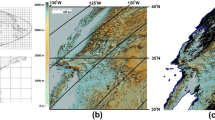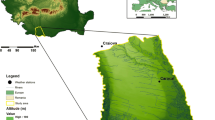Abstract
The selective variance reduction technique that applies linear regression models to the principal components of multi-temporal night monthly averaged land surface temperature (LST) imagery splits the variance associated to elevation, latitude, longitude in SW USA for the year 2007. The reconstructed multi-temporal imagery indicate the positive or negative deviation (thermal anomaly) from the elevation, latitude, longitude predicted LST. The spatial pattern of thermal anomalies is revealed by K-means clustering. The thermal anomaly clusters are parametrically represented according to both the (a) monthly averaged deviation from the elevation, latitude, longitude predicted LST as well as (b) the monthly averaged positive normalized difference vegetation index in an attempt to determine the vegetation density temporal variability per thermal anomaly cluster. This research effort will contribute to aridity and terrain evaluation studies, allowing terrain characterization and planning in the context of the upcoming climatic change.







Similar content being viewed by others
References
Wan, Z. (2013). Collection-6, MODIS land surface temperature products. Users’ guide. Earth Research Institute (ERI). University of California, Santa Barbara. http://www.icess.ucsb.edu/modis/LstUsrGuide/MODIS_LST_products_Users_guide_C6.pdf. Accessed 25 March 2016.
Wan, Z. (2014). New refinements and validation of the collection-6 MODIS land-surface temperature/emissivity products. Remote Sensing of Environment, 140, 36–45.
Miliaresis, G. (2014). Daily temperature oscillation enhancement of multi-temporal LST imagery. Photogrammetric Engineering and Remote Sensing, 80, 423–428.
Miliaresis, G. (2009). Regional thermal and terrain modeling of the Afar depression from multi-temporal night LST data. International Journal of Remote Sensing, 30, 2429–2446.
Miliaresis, G. (2012). Selective variance reduction of multi-temporal LST imagery in the East Africa Rift System. Earth Science Informatics, 5, 1–12.
Miliaresis, G. (2012). Elevation, latitude/longitude decorrelation stretch of multi-temporal LST imagery. International Journal of Remote Sensing, 33, 6020–6034.
Miliaresis, G. (2013). Terrain analysis for active tectonic zone characterization, a new application for MODIS night LST (MYD11C3) dataset. International Journal of Geographical Information Science, 27, 1417–1432.
Miliaresis, G. (2014). Spatiotemporal patterns of land surface temperature of Antarctica from MODIS Monthly LST data (MYD11C3). Journal of Spatial Science, 59, 157–166.
Didan, K. (2015). MYD13C2 MODIS/TAqua vegetation indices monthly L3 global 0.05Deg CMG V006. NASA EOSDIS Land Processes DAAC. 10.5067/MODIS/MYD13C2.006. Accessed 25 March 2016.
Tucker, C. J. (1979). Red and photographic infrared linear combinations for monitoring vegetation. Remote Sensing of Environment, 8, 127–150.
Karnieli, A., Agam, N., Pinker, R. T., Anderson, M., Imhoff, M. L., Gutman, G. G., et al. (2010). Use of NDVI and land surface temperature for drought assessment: Merits and limitations. Journal of Climate, 23, 618–633.
Garcia, M., Fernández, N., Villagarcía, L., Domingo, F., Puigdefábregas, J., & Sandholt, I. (2014). Accuracy of the temperature-vegetation dryness index using MODIS under water-limited vs. energy-limited evapotranspiration conditions. Remote Sensing of Environment, 149, 100–117.
Jolliffe, I. (2002). Principal component analysis (2nd ed.). New York: Springer.
Miliaresis, G. (2012). Elevation, latitude/longitude decorrelation stretch of multi-temporal LST imagery. Photogrammetric Engineering and Remote Sensing, 78, 151–160.
Mather, P. M., & Koch, M. (2011). Computer processing of remotely-sensed images (4th ed.). New York: Wiley.
Miliaresis, G. (2013). Thermal anomaly mapping from night MODIS imagery of USA, a tool for environmental assessment. Environmental Monitoring and Assessment, 185, 1601–1612.
Miliaresis, G. (2016). Selective variance reduction, octave implementation. SourceForge Project, http://selective-variance-reduction.sourceforge.net. Accessed 25 March 2016.
Miliaresis, G. (2016). Revealing the precipitation dependency of regional in time and in space thermal anomaly peaks in SW USA. Modeling Earth Systems and Environment. doi:10.1007/s40808-016-0093-y.
Landam, S., & Everitt, B. S. (2004). A handbook for statistical analysis using SPSS. New York: Chapman and Hall/CRC Press.
Miliaresis, G. (2016). An unstandardized selective variance reduction script for elevation, latitude & longitude decorrelation stretch of multi-temporal LST imagery. Modeling Earth Systems and Environment. doi:10.1007/s40808-016-0103-0.
Wang, S. Y., & Gillies, R. R. (2012). Climatology of the U.S. inter-mountain west. In S.-Y. Wang & R. R. Gillies (Eds.) Modern climatology. InTech, pp 153–176. http://www.intechopen.com/books/modern-climatology/climatology-of-the-u-s-intermountain-west. Accessed 25 March 2016.
Barnett, T. P., & Pierce, D. W. (2008). When will lake mead go dry? Water Resources Research, 44, W03201. doi:10.1029/2007WR006704.
Farr, T. G., & Kobrick, M. (2000). Shuttle radar topography mission produces a wealth of data. American Geophysical Union EOS, 81, 583–585.
SRTM30. (2015). SRTM30 Digital Elevation Model, Version 2.1. US Geological Survey. http://e4ftl01.cr.usgs.gov/SRTM/SRTMGL30.002/. Accessed 25 March 2016.
MYD11C2. (2016). Aqua-MODIS monthly LST imagery, version 006. http://e4ftl01.cr.usgs.gov/MOLA/MYD11C3.006/. Accessed 25 March 2016.
Acknowledgments
The author thanks the 2 anonymous reviewers for their comments, suggestions and corrections.
Author information
Authors and Affiliations
Corresponding author
Rights and permissions
About this article
Cite this article
Miliaresis, G.C. NDVI signatures of regional in time and in space thermal anomalies in SW USA. Spat. Inf. Res. 24, 267–277 (2016). https://doi.org/10.1007/s41324-016-0028-8
Received:
Revised:
Accepted:
Published:
Issue Date:
DOI: https://doi.org/10.1007/s41324-016-0028-8




